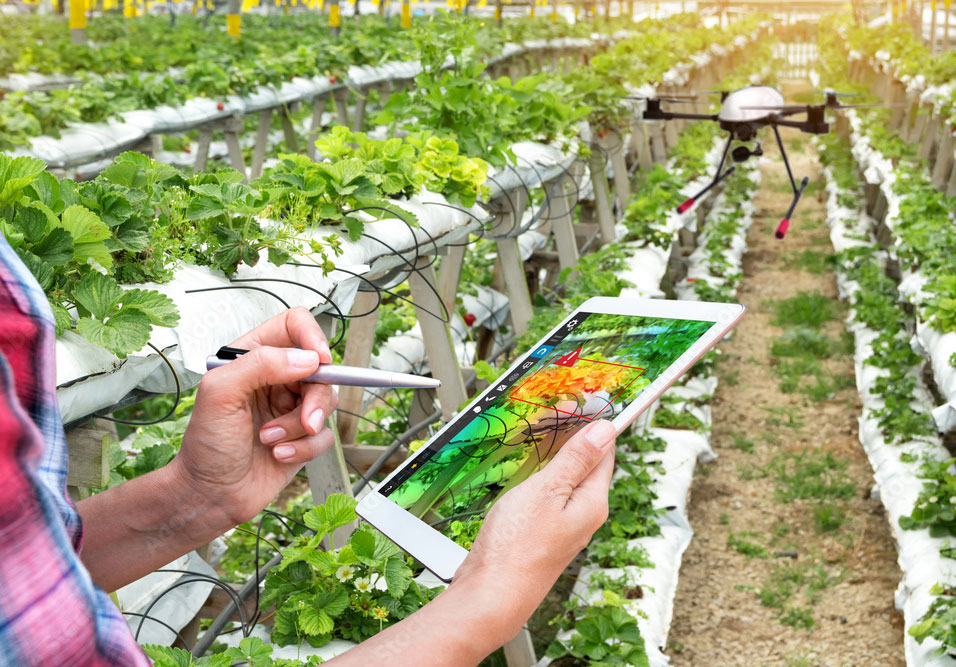APR
High tech meets hard work — Emerging Ag Tech to give students tools to shape future
 A drone rises quietly over open pasture, its camera sweeping across a patchwork of
fields where cattle graze and irrigated crops stretch toward the horizon. Below, a
rancher taps data into a tablet, adjusting her grazing rotation plan based on real-time
images and information collected from the sky. For her, this isn’t futuristic — it’s
just another day on the job.
A drone rises quietly over open pasture, its camera sweeping across a patchwork of
fields where cattle graze and irrigated crops stretch toward the horizon. Below, a
rancher taps data into a tablet, adjusting her grazing rotation plan based on real-time
images and information collected from the sky. For her, this isn’t futuristic — it’s
just another day on the job.
Scenarios like this one are becoming increasingly common in modern agriculture, where technology and tradition are merging to meet the demands of a growing world. And at Laramie County Community College, the new Emerging Agriculture Technology Program is preparing students to lead this evolution.
The Emerging Agriculture Technology Program — or EAT, as students and staff have come to call it — is the latest addition to LCCC’s Agriculture & Equine Pathway. It’s a program designed for students who are as comfortable with data analytics and software as they are with livestock and soil. Launching in Fall 2025, the program addresses an urgent need in modern agriculture: bridging the gap between traditional practices and advanced technology to meet the challenges of a growing, hungry world.
“In large-scale operations, you need technology to track every animal and every input from conception to consumption,” said Lindsey Freeman, LCCC faculty member and one of the program’s architects. “Consumers are demanding transparency — they want to know where their food came from, how it was raised, and what kind of impact it had on the environment. Technology gives producers the tools to answer those questions.”
While the roots of precision agriculture have been planted for years — especially in crop production — Freeman said LCCC saw an opportunity to expand that mindset beyond the fields and into livestock management, conservation and beyond. That realization sparked the creation of EAT. Rather than focusing solely on crop production, the program offers a comprehensive view of technology’s role in agriculture.
Students can specialize in areas like conservation, data analytics, livestock technology and marketing, with plans to add smart farm systems in the future. They explore real-world issues in courses like Issues in Agriculture, then develop solutions through creative entrepreneurship and hands-on experiences. The program even includes an industry immersion class where students travel to cutting-edge operations using emerging ag technologies.
The integration of technology into ag education isn’t just about keeping up with industry trends. It’s about ensuring the longevity and sustainability of agriculture itself, Lindsey said. Producers today face pressures from every angle: economic viability, environmental conservation, and social responsibility. Data-driven decision-making helps strike a balance between these competing demands.
“Implementing tech in ag isn’t cheap,” Freeman said. “But the payoff is long-term stability, reduced waste, and proof that producers are doing things right. It’s an investment in the future — both for the operation and the consumer.”
Agriculture, after all, remains one of the most critical sectors to human survival. Fewer than 2% of Americans are involved in production agriculture, yet they feed and clothe the other 98%. If the next generation of producers can’t step up, the ripple effects will be felt in grocery stores and dinner plates around the world.
That’s why EAT is designed to appeal not just to students from ag backgrounds but also to those who never imagined themselves working in agriculture. For someone skilled in data analytics or IT, this program offers a new avenue into a field that’s constantly evolving and vitally important. Freeman says she asks prospective students: “Do we want an IT person who can learn ag, or an ag person who knows IT?” Most often, the answer is both — and that’s the niche EAT is filling.
“We have students who might’ve never set foot on a ranch before,” Freeman said. “But they know data, and they can make a huge difference in how an operation runs.”
For Wyoming’s economy, the program offers another pathway toward diversification. Integrating emerging technologies and encouraging entrepreneurship within agriculture helps expand opportunities in a state long dependent on its natural resources. Whether students plan to join an established company, return to the family ranch or start something entirely new, EAT prepares them to innovate.
And this program doesn’t stand alone. It’s part of a broader Agriculture & Equine Pathway at LCCC that includes programs in animal science, equine management, veterinary technology and more — each with an emphasis on applied learning and industry relevance. Together, these programs are helping develop the next generation of producers and problem-solvers, not just for Wyoming but for the nation.
“Agriculture feeds and sustains every community,” Freeman said. “The people who go through our programs are the ones who are going to make sure we continue to have access to safe, healthy, abundant food.”
